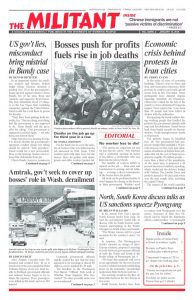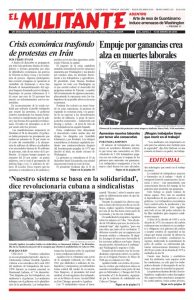NAGASAKI, Japan — The differing class origins and perspectives of the millions of people who made up the Chinese “diaspora” over the last 200 years, and how these differences affected their struggles against discrimination, were discussed and debated at an ISSCO session entitled “Localized Chinese.”
On the panel, Lily Rose Tope, from the University of the Philippines in Manila, spoke about the experiences of Chinese settlers in Malaysia and the Philippines, and Mary-Alice Waters, president of Pathfinder Press and a leader of the Socialist Workers Party, spoke on “Capitalism and Anti-Chinese Racism: Insights from the Divergent Courses of Class Struggle in Cuba and the United States.” Lindsay Herman, a graduate student at the University of Saskatchewan, spoke on how government social services are provided to retired Chinese-Canadians. Li Zong, from the same Canadian university, chaired the panel.
“In Cuba there is no discrimination or prejudice against Chinese,” Waters said. That can’t be said of any other country in the world where large numbers of Chinese have settled. “The most important measure taken against discrimination was the 1959 revolution itself,” she said, quoting Moisés Sío Wong, one of three revolutionary Cuban leaders and generals interviewed in Pathfinder’s Our History Is Still Being Written: The Story of Three Chinese-Cuban Generals in the Cuban Revolution.
Wong and the two other generals, Armando Choy and Gustavo Chui, fought in the underground struggle and revolutionary war that brought down the Batista dictatorship in 1959. Many thousands of Chinese-Cuban working people and youth joined in the revolutionary movement.
At the same time, Waters said, some capitalist-minded Chinese-Cubans sided with the U.S.-backed dictator. This wealthy layer’s long-time domination of politics in the Chinese-Cuban community was broken by the revolutionary upsurge, and particularly by the Chinese who joined the revolution’s ranks and leadership.
The first Chinese in Cuba
Such class divisions were far less of a factor 100 years earlier among the some 150,000 Chinese who landed in the Spanish colony of Cuba in the mid-19th century. In their great majority, Waters said, they were working people, just like their contemporaries who arrived in the U.S. on a similar scale.
The social weight of these first Chinese-Cubans was much greater, however. In the U.S., Chinese were frequently isolated in the gold prospecting regions of California or in temporary labor camps as the construction of railroads spread across the West. In Cuba they served as indentured labor on the big sugar plantations, producing the country’s most important export crop.
Fighting with great distinction alongside escaped African slaves in the liberation wars of 1868-78 and 1895-98, these workers played a key part in the Cuban struggle for independence from the Spanish crown. The Chinese in the U.S. were largely isolated from the revolutionary upheaval of the 1861-65 Civil War and the Radical Reconstruction battles that followed, through which the southern slavocracy was defeated and slavery and indentured servitude outlawed. At the same time, Waters emphasized, the Chinese struggle for equal rights got a big boost from these revolutionary advances.
The subsequent bloody reaction that accompanied the defeat of Radical Reconstruction and the imposition of Jim Crow segregation in the South, Waters said, in turn reinforced growing scapegoating and pogroms against Chinese immigrants in the U.S., including the blanket exclusion of Chinese immigrants that lasted from 1882 until the Second World War.
Chinese in Malaya, Philippines
Speaking next, Lily Rose Tope discussed how two novels depicted the lives of settlers from China in 19th century Malaya and 20th century Philippines.
One such account, A Bit of Earth by Suchen Christine Lim, shows how Chinese-born workers — the class brothers of the first Chinese in the U.S. and Cuba — pioneered Malaya’s tin mining industry in the 1820s. As British military and economic power forced Malaya into the British Empire in the late 19th century, the miners’ labor became a rich source of profits for British capitalists. By contrast, Chinese settlers in the Philippines tended to be wealthy merchants and traders — a distinction clarified in an exchange among the panelists and members of the audience.
Fearful of revolution by workers and peasants of all nationalities, the British colonial regime in Malaya pursued a cold-blooded policy of divide and rule, segregating the large indigenous Malay population from the Indian and Chinese communities, a policy that has continued to be implemented by post-independence capitalist governments in Malaysia.
Linda Harris contributed to this article.

